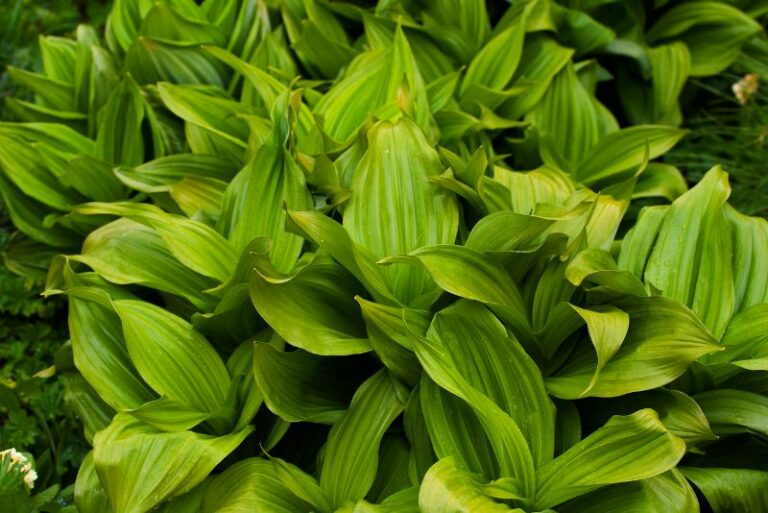Society Garlic: Not Really Garlic, But Great
Are you tired of the same old boring garlic flavor in your dishes? Ready to spice things up and discover a whole new world of culinary wonders? Well, my fellow foodies, prepare to have your taste buds tantalized because today we’re diving headfirst into the enchanting world of society garlic! Now, I know what you’re thinking – garlic, right? But hold on to your aprons, because society garlic is not your typical pungent bulb.
No, no, my friends, this little gem may not be technically classified as garlic, but it sure knows how to pack a flavorful punch that will leave you wanting more. So grab your chopping board and let’s explore the deliciously mysterious world of society garlic together, shall we?
Society Garlic Overview
| Attribute | Description |
|---|---|
| Common Name(s) | Society Garlic |
| Scientific Name | Tulbaghia violacea |
| Family | Amaryllidaceae |
| Height | 1-2 feet |
| Light | Full sun to part shade |
| Water | Moderate; it’s drought-tolerant once established |
| Soil | Well-draining, loamy or sandy soil; pH 6.1 to 7.8 |
| Fertilizer | Use a balanced, slow-release fertilizer in spring |
| Pests and Diseases | Generally pest-free; occasionally affected by slugs or snails |
Please note that this is a general overview. Depending on the specific variety of Society Garlic and the growing conditions in your area, some of these details may vary. Always consult with a local horticulturalist or extension service for the most accurate information.
All About Society Garlic

Society Garlic, scientifically known as Tulbaghia violacea, is a fast-growing, bulbous plant native to southern Africa. This versatile plant is a popular choice among gardeners due to its attractive clusters of lavender or violet flowers, and its vivid green, slender leaves that carry a strong garlic scent.
The name ‘Society Garlic’ is said to come from the belief that, unlike traditional garlic, its consumption would not lead to bad breath, making it more ‘sociable’.
This perennial plant is particularly renowned for its hardiness, capable of surviving in a range of conditions, from droughts to frost. It thrives in full sun to light shade, and well-drained soil is ideal for its growth. The plant blooms in the summer and the flowers often last until fall, adding a long-lasting splash of color to any garden.
Aside from its ornamental value, Society Garlic has been used in traditional medicine for its antifungal, antiviral, and antibacterial properties. The leaves and rhizomes are often used in soups and salads, or as a garlic substitute in various dishes. However, it’s important to note that some people may experience stomach discomfort from eating it.
In terms of maintenance, Society Garlic requires minimal care. Regular watering during the growing season and occasional feeding with a general-purpose fertilizer will keep the plant healthy. One of the main concerns can be its tendency to self-seed abundantly, which might lead to it taking over other plants in the garden if not controlled.
To propagate Society Garlic, you can divide the clumps in the fall or early spring. It’s also possible to grow new plants from the seeds, although this method involves a long wait for the plants to reach maturity.
In conclusion, Society Garlic is a low-maintenance plant that offers visual appeal and aromatic allure, making it a fantastic addition to any garden. Its hardiness and adaptability mean it can thrive in a variety of conditions, and its attractive foliage and flowers can provide a vibrant backdrop in any outdoor space.
Varieties of Society Garlic
1. Tulbaghia violacea ‘Silver Lace’
Also known as Variegated Society Garlic, ‘Silver Lace’ is a cultivar with striking variegated leaves. The leaves feature a white edge, providing a stark contrast against the green, giving it the appearance of being framed in silver, hence the name. The plant was bred for its unique coloration, and its flowers are similar to those of the common Society Garlic. The scent is a bit milder, but still distinctly garlicky.
2. Tulbaghia violacea ‘Tricolor’
‘Tricolor’ is another variant, characterized by its three-toned foliage. Each leaf features shades of green, cream, and pink, making it an attractive addition to any garden. This variety was first cultivated for its distinctive color pattern. Its flowers are lavender in color, similar to the original species, and it maintains a strong garlic scent.
3. Tulbaghia violacea ‘Fairy Star’
This cultivar, ‘Fairy Star’, is known for its delicate, petite flowers. Each flower cluster is smaller than on the standard variety, giving it an enchanting, star-like appearance. It was specifically bred with smaller flowers to appeal to gardeners seeking more delicate-looking plants. The plant’s leaves release a noticeable garlic odor when crushed.
4. Tulbaghia simmleri
Tulbaghia simmleri, or Pink Agapanthus as it’s commonly known, is actually a separate species from Tulbaghia violacea, but it’s often mistaken as a variety of Society Garlic due to the similarities in leaf shape and the garlic scent. This species bears soft pink flowers and has a stronger, more robust garlic aroma compared to the other varieties.
Each one of these Society Garlic varieties has its own unique appeal, but they all share the plant’s traditional hallmarks: visually striking flowers, distinct garlic aroma, and hardy nature. Regardless of the variety you choose, Society Garlic offers a unique blend of beauty and resilience, making it an excellent choice for your garden.
Society Garlic Care Procedures

The Society Garlic is a fairly low-maintenance plant, but it still requires some care to ensure healthy growth and abundant blooms. Here are some essential care procedures to keep in mind:
Light and Temperature
Light: Society Garlic thrives in full sun to partial shade. It needs at least six hours of bright, direct sunlight each day for optimal growth and blooming. If you’re growing it inside, place it near a south or west-facing window where it can get ample sunlight. If the sunlight is too intense and causes scorching, you can shield the plant using a sheer curtain.
Temperature: This plant is remarkably adaptable in terms of temperature. It can withstand a range of climates, from hot summers to cold winters. The ideal temperature for Society Garlic is between 50 to 85 degrees Fahrenheit. It can survive light frost, but if the temperature drops below freezing for an extended period, it’s best to move your Society Garlic indoors or provide some type of frost protection. Remember, although Society Garlic is frost resistant, it’s not frost-proof.
In hot climates, ensure the plant has a sufficient water supply to prevent drying out. Society Garlic is a drought-tolerant plant, but it will flourish best with regular watering in extreme heat.
In a nutshell, providing your Society Garlic with the right amount of light and maintaining an optimal temperature range will ensure your plant’s health and vitality. It’s these simple but important care procedures that can make a significant difference in the growth of your Society Garlic.
Water and Humidity
Water: Society Garlic is a drought-tolerant plant, meaning it can survive periods of low water supply. However, for optimal growth and blooming, it should be watered regularly. The soil should be allowed to dry out between watering sessions to prevent root rot. Overwatering can lead to waterlogged soil and potentially lethal conditions for the plant.
In the growing season (spring and summer), water the plant deeply once a week. In the dormant season (fall and winter), reduce watering to once every two weeks or less. Always check the top inch of soil for dryness before watering. If it’s dry, it’s time to water; if it’s still moist, wait another day or so.
Humidity: Society Garlic isn’t particularly sensitive to humidity levels and can thrive in both low and high humidity environments. However, in very dry conditions, the plant’s leaves might start to brown at the edges. If this happens, misting the foliage can help increase humidity. In high humidity, ensure that your plant is getting enough sunlight and has proper air circulation to prevent potential fungal diseases.
In conclusion, while Society Garlic is quite resilient and can survive under various conditions, giving it the appropriate amount of water and maintaining a suitable humidity level can significantly enhance the health and appearance of your plant. It’s all about finding the right balance and making minor adjustments based on the specific conditions in your home or garden.
Soil, Ph and Prepare soil
Society Garlic, also known as Tulbaghia violacea, is a popular ornamental plant that is grown for its attractive foliage and fragrant flowers. This hardy perennial is native to South Africa and has become a favorite among gardeners around the world.
In this guide, we will discuss the various soil types and pH levels suitable for growing society garlic, as well as how to prepare your soil for optimal plant growth.
Soil Types
Society garlic can adapt to a range of soil types, but it thrives best in well-drained, fertile soil. Here are some common soil types that are suitable for growing society garlic:
- Loamy Soil: This type of soil is a combination of sand, silt, and clay particles. It is well-draining and has good water retention capacity, making it ideal for growing society garlic.
- Sandy Soil: Society garlic can also grow in sandy soil, which is light and airy. However, this type of soil tends to dry out quickly and may need more frequent watering.
- Clay Soil: While society garlic can tolerate clay soil, it is not the most ideal for this plant. Clay soil tends to be heavy and compacted, making it difficult for the roots to grow and thrive.
pH Levels
The pH level of your soil plays a crucial role in the growth and development of society garlic. The optimal pH range for this plant is between 6.0-7.5, which is slightly acidic to neutral.
If your soil’s pH level is too low or too high, it can affect the plant’s ability to absorb nutrients from the soil and lead to stunted growth. To determine your soil’s pH level, you can use a simple testing kit available at most garden centers.
Soil Preparation
Proper soil preparation is vital for the successful growth of society garlic. Here are some steps you can follow to prepare your soil:
- Clear the area: Start by removing any weeds, rocks, or debris from the planting area.
- Amend the soil: If your soil is heavy and clay-like, you can improve its texture and drainage by adding organic matter such as compost or aged manure.
- Mix in nutrients: Society garlic is a heavy feeder and requires fertile soil to thrive. Before planting, mix in a slow-release fertilizer into the soil to provide essential nutrients for the plant’s growth.
- Test pH level: Use a testing kit to check your soil’s pH level and make any necessary
Fertilizer
Society Garlic can grow well even without much fertilization. However, for the best growth and flowering, providing the plant with a balanced fertilizer can be beneficial. Here’s a step-by-step guide on how to fertilize your Society Garlic:
- Type of Fertilizer: Choose a balanced, slow-release fertilizer with a ratio of Nitrogen (N), Phosphorus (P), and Potassium (K) such as 10-10-10 or 14-14-14. These numbers represent the percentage of each nutrient in the fertilizer. A balanced fertilizer will provide all the necessary nutrients in equal amounts, promoting overall plant health and blooming.
- When to Apply: The best time to fertilize Society Garlic is during its active growing season, which is generally spring and summer. Start applying the fertilizer in early spring when new growth appears and continue until late summer.
- How to Apply: Follow the package instructions for the exact amount to use. Generally, sprinkle the fertilizer around the base of the plant, keeping it a few inches away from the stem to avoid burning the roots. After applying, water the plant thoroughly, which will help dissolve the fertilizer and carry it to the roots.
- Frequency: Fertilize your Society Garlic once a month during the growing season. Do not fertilize in the dormant season (fall and winter), as the plant needs less nutrition during this time.
Remember, over-fertilizing can be harmful to your plant. Signs of over-fertilization include leaf burn, wilting, or slow growth. If you observe these symptoms, cease fertilizing and flush the soil with plenty of water to wash away the excess nutrients.
In summary, while Society Garlic is not particularly demanding in terms of fertilization, a bit of extra nutrition during the growing season can enhance its growth and flowering. As always, it’s best to observe your plant’s response and adjust your care practices accordingly.
Repotting
Repotting Society Garlic can help ensure its continued growth and health. Over time, as the plant grows, it may outgrow its current pot, leading to cramped roots and stunted growth. Here’s a detailed guide on how to repot Society Garlic:
- When to Repot: The best time to repot Society Garlic is in the spring, just before the growing season starts. However, if you notice that your plant has become root-bound or the growth has slowed significantly, it could be a sign that it’s time to repot regardless of the season.
- Choose the Right Pot: Choose a pot that is one to two sizes larger than the current one. Ensure that it has ample drainage holes to prevent waterlogging. If you’re using a clay pot, soak it in water for a few hours before repotting, as dry clay can wick moisture away from the soil.
- Prepare the Pot: Cover the drainage holes with a piece of broken pottery or a screen to prevent soil from washing out. Then, add a layer of fresh, well-draining soil to the bottom of the pot.
- Remove the Plant: Carefully remove the Society Garlic from its current pot. Gently shake off excess soil from the roots and inspect them for any signs of disease or pests. Trim off any black or mushy roots.
- Repot the Plant: Place the plant in the new pot at the same depth it was growing before. Fill the pot with soil, making sure to cover the roots but not the stem. Firm the soil around the plant to ensure it’s well-seated.
- Aftercare: After repotting, water the plant thoroughly. Keep the plant in a shaded location for a week or so to allow it to recover from the transplant stress. After that, you can move it back to its usual spot.
In summary, repotting Society Garlic can help ensure its continued healthy growth. However, it’s important to repot only when necessary and to provide proper aftercare to minimize transplant stress.
Propagation
Propagation is another fantastic way to expand your collection of Society Garlic plants. Not only is it cost-effective, but it’s also quite simple and fun. Here’s a step-by-step guide on how to propagate Society Garlic plants from divisions, cuttings, and seeds.
Divisions:
As mentioned in the repotting segment, Society Garlic can be effectively propagated by division. Here’s a quick recap:
- Carefully remove the Society Garlic plant from the pot.
- Using your hands or a clean, sharp knife, divide the plant at the root ball into multiple sections, ensuring each section has at least one shoot.
- Plant each division in a new pot with well-draining soil.
- Water the new plants thoroughly and place them in a location with similar light conditions as the parent plant.
Cuttings:
Another method is stem cuttings. Here’s how:
- Cut a healthy stem (about 4-6 inches long) from an existing Society Garlic plant using a clean, sharp tool.
- Remove the leaves from the bottom half of the cutting.
- Dip the cut end into a rooting hormone (optional but can improve results).
- Plant the cut end into a pot filled with a well-draining medium, such as a mix of perlite and peat moss.
- Cover the pot with a plastic bag or place it in a propagation box to create a humid environment.
- Position the pot in a bright location, out of direct sunlight. Keep the soil moist but not waterlogged.
- Roots should start forming in a few weeks. Once the cutting has established roots, it can be transplanted to a larger pot or directly into the garden.
Seeds:
Lastly, you can grow Society Garlic from seeds:
- Start by sowing the seeds indoors in a seed tray filled with seed compost. Lightly cover the seeds with compost or vermiculite.
- Keep the seed tray in a warm, bright location, out of direct sunlight.
- Keep the compost consistently moist but avoid overwatering.
- The seeds should germinate within a few weeks. Once the seedlings are large enough to handle, they can be transplanted into individual pots.
- Once the risk of frost has passed, the young plants can be moved outside into their final growing position.
In summary, propagation of Society Garlic can be done through divisions, cuttings, or seeds. While each method has its own requirements and timelines, all can result in new, healthy plants with the right care.
Pruning
Pruning Society Garlic is crucial for maintaining its aesthetics, promoting growth, and preventing disease. Here is a step-by-step guide on how to prune Society Garlic:
- When to Prune: Society Garlic should be pruned in the early spring before new growth begins. However, it’s also good practice to remove spent flowers and yellow leaves throughout the growing season to keep the plant looking its best.
- Tools Required: For pruning Society Garlic, you will need a pair of sharp, clean gardening shears or scissors. Disinfect the blades before use to avoid introducing any diseases to the plant.
- Pruning for Size and Shape: Prune the plant to the desired size and shape, cutting back the stems to a set of leaves.
- Removing Dead or Yellow Leaves: Dead or yellow leaves not only detract from the plant’s appearance but can also harbor disease. Carefully remove these leaves, cutting them off at the base.
- Deadheading: Deadheading, or removing spent flowers, encourages the plant to produce more blooms. Simply snip off the flower head once it has wilted.
- Pruning for Health: Look out for signs of disease or pests on the plant such as dark spots, distorted growth, or pest presence. If found, the affected parts should be pruned away to prevent further spread.
- Aftercare: After pruning, dispose of the cuttings properly to avoid any disease spread. Keep an eye on the plant for any signs of stress and provide appropriate care.
In summary, regular pruning of Society Garlic can stimulate growth, maintain its health, and enhance its appearance. Always keep the tools clean and make the cuts carefully, and your Society Garlic should thrive.
Troubleshooting Society Garlic
Growing Society Garlic is generally a simple process, but like all plants, they can still face certain issues. This section will provide a comprehensive guide to troubleshooting common problems, identifying pests, and managing diseases in Society Garlic plants.
Growing Problems:
- Yellow Leaves: If your Society Garlic plant is developing yellow leaves, it could be due to overwatering, underwatering, or lack of nutrients. Check the soil moisture levels and adjust your watering schedule if necessary. If the issue persists, consider re-potting the plant in a nutrient-rich soil.
- Stunted Growth: Stunted growth or lack of flowering can be due to insufficient light or inadequate nutrients. Ensure your plant is positioned in a location with plenty of indirect light and consider adding a slow-release fertilizer to the soil.
- Leaf Tip Burn: If the leaf tips appear burnt or brown, it may be due to a lack of humidity or over-fertilization. Increase the humidity around your plant and reduce the frequency of fertilization.
Pests:
Society Garlic can occasionally be affected by pests such as:
- Aphids: These small, soft-bodied insects can cause distorted growth and yellowing leaves. Treat by spraying the plant with a mild soapy water solution or using a commercial insecticide.
- Snails and Slugs: These pests enjoy the juicy leaves of the Society Garlic. Use a commercial molluscicide or introduce natural predators into your garden.
Diseases:
Society Garlic is generally disease-resistant but can occasionally be affected by:
- Root Rot: Overwatering can lead to root rot, a fungal disease that causes black, mushy roots and wilting. If you notice these symptoms, remove the affected parts and repot the plant in fresh, well-draining soil.
- Powdery Mildew: This is a fungal disease that causes a white, powdery coating on the leaves. It can be treated with a commercial fungicide or a homemade solution of baking soda and water.
In conclusion, while Society Garlic is a resilient plant, it can face issues related to growth, pests, and disease. Regular monitoring, appropriate care, and timely intervention can ensure that your Society Garlic thrives.
Frequently Asked Questions about Society Garlic
Q1: How often should I water my Society Garlic plant?
A: Society Garlic prefers soil that is consistently moist, but not waterlogged. During the growing season, watering it once or twice a week should suffice. In the cooler months, reduce the watering frequency as the plant’s water requirements decrease.
Q2: Can Society Garlic grow in shade?
A: Although Society Garlic prefers full sun to partial shade, it can tolerate shady conditions. However, too little sunlight can result in stunted growth and fewer blooms.
Q3: Is Society Garlic deer resistant?
A: Yes, Society Garlic is considered deer-resistant. However, it’s important to note that “resistant” does not mean “deer-proof.” In areas with high deer populations, the plant may still be nibbled on.
Q4: Why does my Society Garlic not flower?
A: Lack of flowering in Society Garlic could be related to insufficient light, inadequate nutrients, or improper watering. Ensure your plant is getting plenty of indirect light, feed it with a slow-release fertilizer, and keep the soil consistently moist.
Q5: Can Society Garlic be grown indoors?
A: Yes, Society Garlic can be grown indoors provided it receives enough light, ideally from a south or west-facing window. It also requires well-draining soil and a pot with drainage holes to prevent waterlogging.






